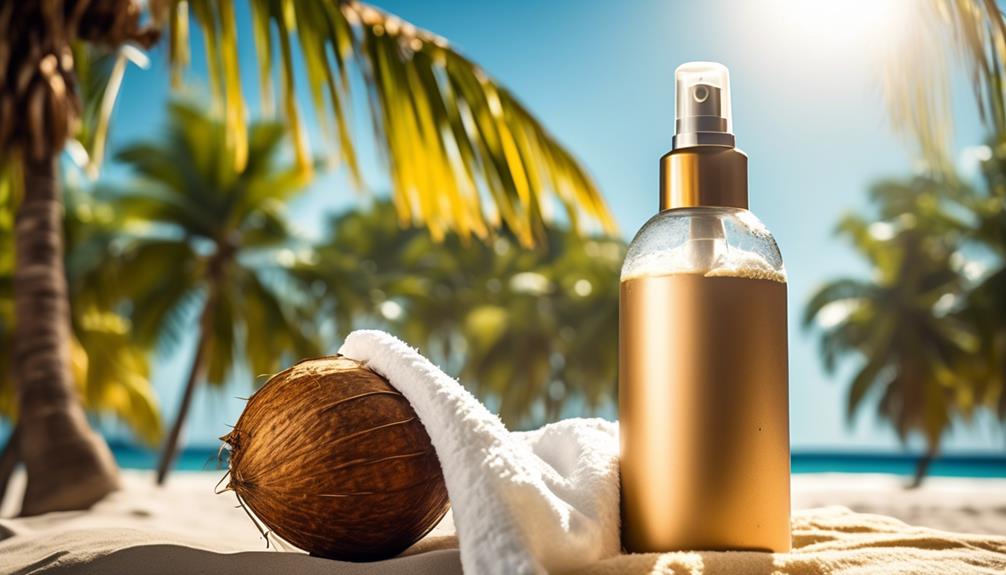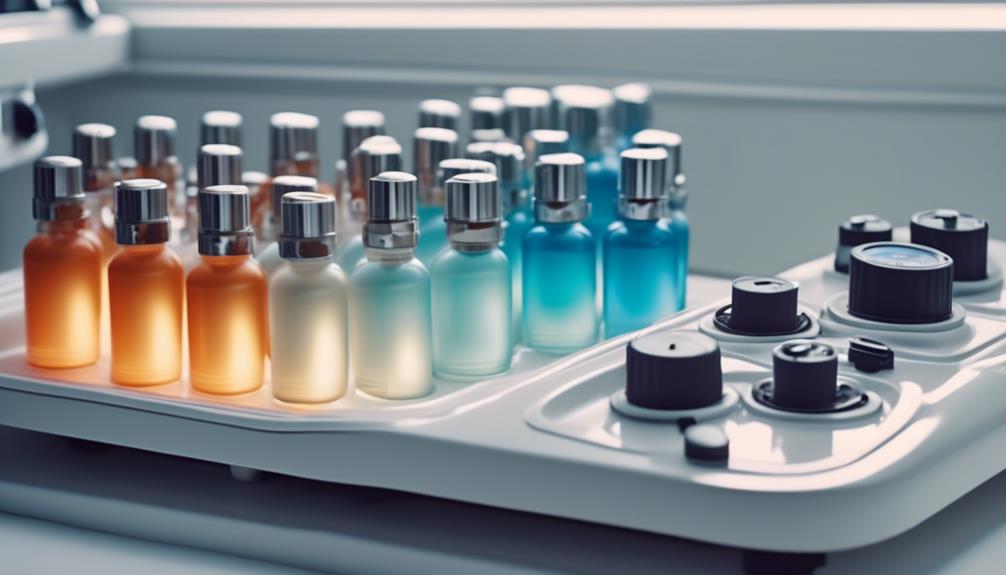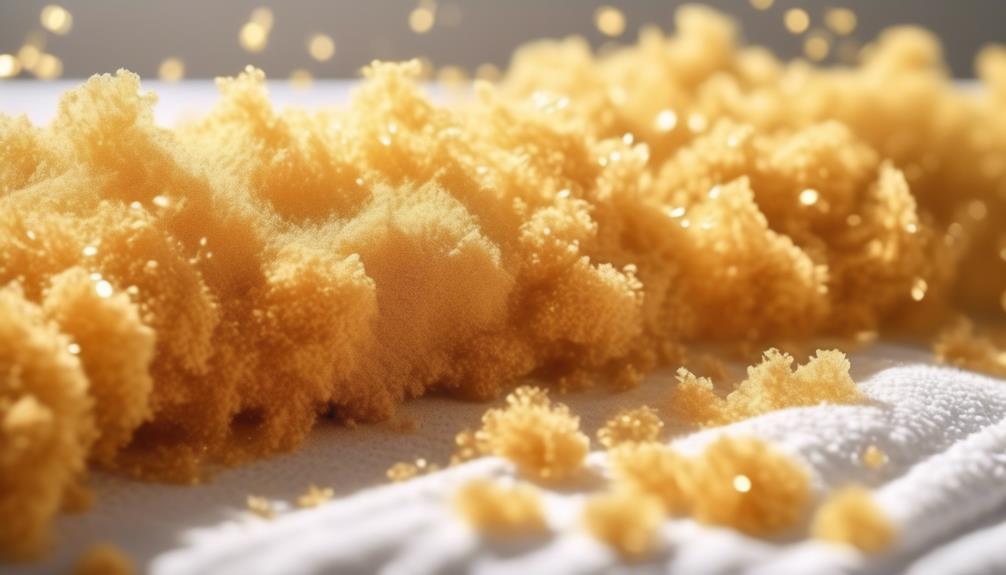You’ve heard the buzz about the golden glow, but let’s chat about what’s too much of a good thing.
Depending on your skin type, you might start with baby steps, a few minutes at a time, or you could be the type to jump in for a longer session. It’s all about knowing your skin’s limits and how to strut the fine line between sun-kissed and sun-scorched.
So, how do you figure out your skin’s sweet spot without overdoing it? Stick around, and let’s uncover the golden rules for safe tanning bed sessions that keep you looking fierce without playing with fire.
Key Takeaways
- Different skin types require different levels of UV exposure, so it is important to determine your skin type before using a tanning bed.
- Start with a conservative time under the tanning bed lamps and gradually increase the time as your skin becomes more tolerant.
- Overexposure to UV rays can lead to skin damage, so it is crucial to avoid excessive tanning bed usage.
- Consider safer alternatives to achieve a tan without UV exposure to reduce the risk of skin cancer.
Understanding Skin Types
Understand your skin type to keep things safe and sassy. Knowing whether you’re a delicate Type 1 or a resilient Type 5 can be a game-changer when it comes to UV exposure. Trust me, using tanning beds isn’t a one-size-fits-all kinda deal.
If you’re rocking that porcelain Type 1 skin, you’ve gotta start slow, like 1-3 minutes slow. You burn easily, and honestly, that’s not the kind of red-hot we’re going for. As you move up the skin type ladder, the rules change. Medium to dark tones, like the Type 5 squad, can handle a bit more, up to 4-10 minutes of that glow time.
Now, let’s keep it real – those tanning bed rays aren’t your skin’s BFF. The American Academy of Dermatology isn’t shy about the risks, so neither will I be. Indoor tanning ups your skin cancer ante, no matter how much melanin magic you’ve got going on.
Before you use those lamps, chat with a tanning pro. They’re the fairy godparents of perfect tanning times and can guide you to safer sunless options. Because, you’re meant to shine, not to suffer.
Initial Exposure Recommendations
Depending on your skin’s vibe, you’ll wanna kick off with just a few minutes under those lamps—think of it as a quick intro, not a full-on hangout.
And remember, it’s not just about day one; we’ll guide you on how often to catch those rays safely.
Understanding Skin Type Sensitivity
Let’s figure out how sensitive your skin is to UV rays so we can nail down the perfect starting time for your tanning bed sessions. Skin type sensitivity is no joke, and using a tanning bed isn’t a one-size-fits-all deal.
If you’re a Skin Type 1, ease into it with a quick 1-3 minute session. Skin Type 2? You’ve got a smidge more leeway—start with 2-4 minutes. Type 3, you’re looking at a 4-8 minute first date with those UV rays. And for the blessed Type 4, you can chill for 4-9 minutes. Type 5, you’ve hit the jackpot with 4-10 minutes.
Recommended first Session Length
Before starting your tanning journey, let’s match your skin type to the ideal first session length to get that glow without the ouch. Tanning beds emit UV rays that can be tough on your skin, so nailing the amount of time you spend under those lamps from the get-go is key.
Here’s how to kick things off:
- Sensitive Snow White (Skin Type 1): Ease in with a mere 1-3 minutes.
- Fair and Cautious (Skin Type 2): Test the waters with 2-4 minutes.
- Middle Ground Maven (Skin Type 3): Dip in for 4-8 minutes.
- Olive and Easy Going (Skin Type 4 & 5): Start your bronze quest with 4-10 minutes.
Stick to the recommended first session length, and you’ll be loving your skin – and that sun-kissed look – safely!
Tanning Bed Usage Frequency
When starting out with tanning beds, it’s crucial to nail down how often you should hit the lights to keep your skin happy and healthy. Depending on your skin type, initial exposure recommendations vary.
If you’re fairer, you’ve got a mere 1-3 minute window before it’s time to peace out. Got a bit more melanin? You might chill for up to 10 minutes. But remember, these sunbeds aren’t a safe bet for that vitamin D fix or a risk-free glow.
Indoor tanning cranks up your chances of skin cancer, and honestly, it’s not worth the gamble. If you’re under 20 and starting early, you’re playing with fire. And, if you find yourself hooked on that bronzed look, it’s time to step back and consider safer, skin-loving options.
Stay savvy with your tanning bed usage frequency to avoid the UV radiation overload.
Tanning Bed Levels Explained
Alright, let’s break down tanning bed levels—you’ve got choices, and they’re not all created equal.
You’re juggling between types and how much UV they’re dishing out, which can totally tweak your tanning time.
Before you hop in, let’s chat about picking the level that won’t just mesh with your skin type but also keep those risks on the low.
Understanding Tanning Bed Types
To get that beach-ready bronze, it’s key to know the different levels of tanning beds and how they crank up the heat on your tan game.
Explore the world of UV light, where tanning bed types are all about the glow-up:
- Level 1: A slow burn for the tan rookie, easing you into the bronze league with gentle UVA and UVB levels.
- Level 2: Crank it up a notch with a stronger UV mix, nudging your tan towards that sun-kissed vibe.
- Level 3: The serious tanners’ choice, blasting a higher intensity for that deep, golden glow.
- Level 4: Ultimate tan lovers, brace for the most intense UV rays, but remember, moderation is your BFF here.
Chat with the pros to find your UV match and remember, safety over sizzle, always.
UV Exposure Variations
Peeling back the layers of tanning bed tech, let’s zero in on how each level dials up the UV intensity to transform your skin from fair to sun flair. Think of a tanning bed as your personal sunshine simulator. But just like real sun exposure, there’s UV radiation to consider. Different beds come with different vibes – low, medium, high – each upping the ante on those UV rays.
Before you bask in that glow, take precautions. Your skin’s no joke, and too much UV can be a party pooper. Start slow, build a base, and keep those sessions short and sweet. Your tan will thank you for not going zero to sixty.
Keep it cool, keep it safe, and keep that tan on point.
Selecting Appropriate Tanning Level
Let’s break down tanning bed levels to find your perfect match. Whether you’re a sun-kissed newbie or a bronzed veteran, selecting the appropriate tanning level is key to a glow that’s both gorgeous and guilt-free. Keep in mind, this isn’t one-size-fits-all; it’s personal, just like your playlist or your pizza toppings.
- Know Your Skin Type: Pale, burn-prone skin? Or olive with a side of natural tan? Identify where you’re at to avoid a UV faux pas.
- Consult the Pros: $5 Tan experts are like your skin’s BFFs, ready to tailor your tanning bed sessions.
- Sunless Options: UV radiation isn’t your only road to radiance. Explore spray tans or lotions for a safer embrace.
- Frequency Matters: Your skin needs a breather. Space out sessions to maintain that healthy, happy glow.
Frequency of Sessions
Understanding how often you should hit the tanning bed is key to maintaining that golden glow without overdoing it. Finding that balance between catching those rays and chilling out is super important. Too much UV radiation? Not the vibe we’re going for. So, let’s break it down to keep you looking fierce without the burnout.
Now, check out this table I’ve whipped up just for you—it’s like your personal roadmap to that sun-kissed look, without the sun’s harsh kiss:
| Session Type | Recommended Frequency | Notes |
|---|---|---|
| Initial Tan | 3-4 times per week | Gradual UV exposure to build base tan |
| Maintenance | 1-2 times per week | Keep the glow without overdoing it |
| Touch Up | As needed | For that little extra before special events |
| Break Period | Every 3-4 weeks | Give your skin a vacay from the bed |
| Overexposure | Not Recommended | That’s a no-go. Keep it safe |
Sticking to a safe limit for your tanning bed sessions isn’t just smart; it’s essential for that endless summer look. Remember, frequency of sessions is all about keeping it cute, not crispy. Keep these tips on lock, and you’re golden—literally.
Duration of Each Session
While you’ve got the frequency of your tanning sessions down, let’s not forget the importance of timing each golden opportunity just right. The duration of each session is crucial because, let’s face it, you want that sun-kissed look without the ouch or ouch-worse.
Here’s how to time your glow-up:
- Know Your Skin Type: If you’re the fairest of them all (Type 1), start with just 1-3 minutes. Climbing the ladder? Type 5 can kick off at a leisurely 4-10 minutes.
- Match the Bed to Your Bod: Different UV radiation levels mean different timings. Chat with a tanning pro to nail down the sweet spot.
- Hydrate for the Win: Keep your skin quenched inside and out. Moisturize to maximize your tan and minimize the harm.
- Slow and Steady Wins the Race: Ramp up the duration of each session gradually. Rushing it’s a no-go.
Maximizing Safety Precautions
Knowing your skin type is like the ABCs of tanning. Check out the Fitzpatrick Scale and get that insight on how your skin vibes with UV radiation. Start slow– don’t crank up the time too fast. Easing into it helps keep those nasty burns and skin damage at bay.
Make sure you’re hydrating and slathering on that moisturizer. Your skin needs that drink to stay lush under the UV glare. And exfoliation? That’s your prep step for an even glow – just remember to ditch the makeup when you hit the salon.
Here’s your cheat sheet for maximizing safety precautions:
| Must-Do | Why It’s Hot | Cool Tip |
|---|---|---|
| Skin Type ID | Avoids overexposure | Fitzpatrick Scale is key |
| Gradual Timing | Reduces burn risk | Slow & steady wins the race |
| Hydration | Keeps skin supple | Drink up & moisturize |
| Exfoliation | Ensures even tan | Do it 24h before |
| Pro Advice | Tailors your tan | Expert tips for days |
Getting expert advice can upgrade your tanning strategy big time – it could mean the difference between a fab tan and increasing the risk of skin cancers. Keep it smart, keep it sexy, and always play it safe with those rays!
Post-Tanning Skincare Tips
After stepping out of the tanning bed, slather on some soothing lotion or aloe vera to chill out your skin and lock in that moisture. You’ve rocked that session like a pro, but now it’s all about keeping that glow gorgeous and your skin happy.
Here’s how you keep your skin looking and feeling like a dream:
- Hydrate Like You Mean It – Chug that H2O! Your skin’s thirsty for some hydration after soaking up all that UV radiation. It’s like giving your skin a big ol’ glass of water after a sunny day out.
- Dress to Impress…Your Skin – Slip into something a little more comfortable. Loose, airy fabrics are the way to go to let your skin breathe and recover from the tanning hustle.
- Exfoliate, But Gently – A couple of days later, buff away any rough patches. It’ll make your tan pop even more and you’ll feel smoother than a fresh jar of Skippy.
- Sunscreen is Your BFF – Before you step outside, layer up on sunscreen. It’s your knight in shining armor against any more UV sneak attacks.
Remember these post-tanning skincare tips and you’ll keep your tan looking fierce and your skin thanking you. Stay fabulous!
Recognizing Overexposure Signs
Recognizing overexposure signs is like catching a bad date before things go south—you gotta know when to bail. When it comes to tanning bed sessions, more ain’t always better. UV radiation can be a sneaky frenemy that feels good but can seriously damage the DNA in your skin cells if you’re not careful.
Here’s a quick cheat sheet to keep you in the glow and out of the woe:
| Signs of Trouble | Why It’s a Buzzkill |
|---|---|
| Skin redness & tenderness | Screams “Help, I’m fried!” |
| Peeling or blistering | Your skin’s SOS for too much UV action |
| Dizziness & nausea | Your body’s way of saying, “Chill” |
If your skin’s throwing shade by changing color unevenly or feeling like a hot mess, you’ve probably overdone it. And don’t ignore your peepers—eye discomfort or funky vision changes are your cue to put a lid on those tanning sessions. Remember, looking like a sun-kissed goddess should feel fab, not drab. So keep it safe, keep it sexy, and don’t let an overzealous tan cramp your style.
Frequently Asked Questions
How Many Tanning Bed Sessions Are Safe?
There’s no one-size-fits-all number. It depends on your skin type and the bed’s intensity.
But remember, even one session ups your skin cancer risk by a lot. So, think about why you’re hitting the bed. Maybe try a sunless tanner instead? It’s way safer and you’ll still get that glow you’re after, without risking your health.
What Is a Safe Amount of Sunbed Use?
Did you know that using a tanning bed just once hikes your melanoma risk by 20%? That’s wild, right?
So, when it comes to sunbeds, less is more. Don’t overdo it—start small, especially if you’re fair-skinned. Chat with a tan guru to nail down your perfect dose.
Consider those rad spray tans for a guilt-free glow. Keep it safe and flaunt that sunny vibe, okay?
How Many Times a Week Can I Go to the Tanning Bed?
Look, less is more here. Even one session can harm your skin, so don’t overdo it.
Aim for minimal exposure and always listen to your skin’s needs. Better yet, embrace your natural glow or go for a self-tanner.
Keep it safe and stylish without risking your health. Remember, you’re gorgeous just as you are!
Is There a Limit to How Much You Can Tan?
Well, that applies to tanning too. Your skin’s gotta limit and you should respect it.
Start low, go slow, and never try to rush a tan. Listen to your body, avoid the burn, and keep those sessions to the minimum.




